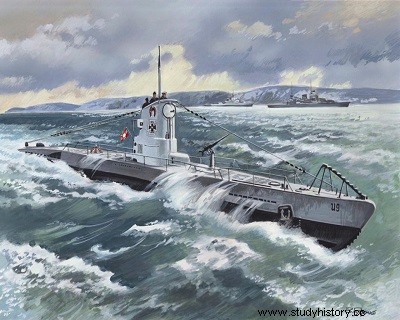. 
The first six months of 1940 had been relatively calm in the Atlantic. Bad weather in January had prevented the submarines from continuing their operations. In addition, a large number had been withdrawn to take part in the Norwegian campaign. But by June they were back, not yet very many as the construction program was just beginning to show results, but nevertheless their quantity was steadily increasing every month.
From the new bases in the Gulf of Biscay, even small U-boats, such as those of 500 tons, could intervene in areas 600 miles away, well beyond the limits allowed to English escorts. At this distance, they encountered little opposition. Merchant ships coming or going did not react to their torpedoes. Closer to shore, they targeted ships which, for speed reasons, had overtaken convoys or were trailing behind them. These too were unresponsive.
In September, the U-Boat Commander began the first serious attacks by "wolf packs" on British convoys. Two successive convoys, the SC-2 and the HX-72 were attacked by a pack of 10 submarines, northwest of Iceland. 16 of their ships were sunk. A month later, an even more violent attack was unleashed.
Again, the victims were two convoys following each other, the SC-7 and the HX-79. A "pack of wolves", made up of 8 submarines, attacked them for four consecutive nights and sank 32 of their ships.
The English had no trouble finding the answer to this kind of attack. One of them, already mentioned, being the installation of radars on escort ships. Another was to find a way to illuminate the darkness in a way more effective than that afforded by the illumination shells fired from the escort guns. Scientists brought the solution by inventing the "snowflake", a very bright glow capable of illuminating a very large area at once.
But, like radar, this solution was still for the future. Another solution was to provide convoys with aerial escort. This solution was effective and powerful for their protection, because the planes firing above the convoys forced the submarines to submerge, causing them to lose contact. When equipped with ASV (airborne radars), escort aircraft had even greater effectiveness because they could detect a submarine in bad weather and at further distances, whereas the human eye couldn't. But then again, at this stage of the battle, the necessary number of long-range aircraft did not exist. The protection they could provide to the convoys would therefore only be provided later.
Yet another possibility was to study submarine shadowing methods. Whoever was directing the rest of the pack towards the convoys had to emit a succession of signals by radio, but if these signals could escape the listening stations on land (because they were transmitted at very low power), they could be heard normally aboard the escorts. Therefore, if these boats were equipped with receivers, they could intercept the spy ship's message and determine its position. In 1940 this way of locating submarines in order to destroy them was, like the others, only in an embryonic state, but it was from that moment that the production of appropriate receivers was undertaken. to equip the escorts.
This was finally achieved in July 1941.
The only thing possible, before that date, was to try to push the escorts as far into the Atlantic as possible and to divert the convoys on different routes, away from the areas where the submarines were supposed to
keep an eye out. This task fell to the Admiralty's tracking service, which used any information it could get. The most fruitful source of information turned out to be the signals emitted by submarines at sea and picked up by stations ashore. Thanks to these signals, we could quickly determine the position of the submarines and warn the convoys that they were in danger. A drastic change in routes was sometimes necessary to avoid submarines. The brightest brains had been assigned to the screening service. Despite this, it was not always easy to do more than grope in the dark for too little information. Later the material of information improved, both in quantity and quality, and the tracing services were to achieve some spectacular successes. But we weren't there yet.
